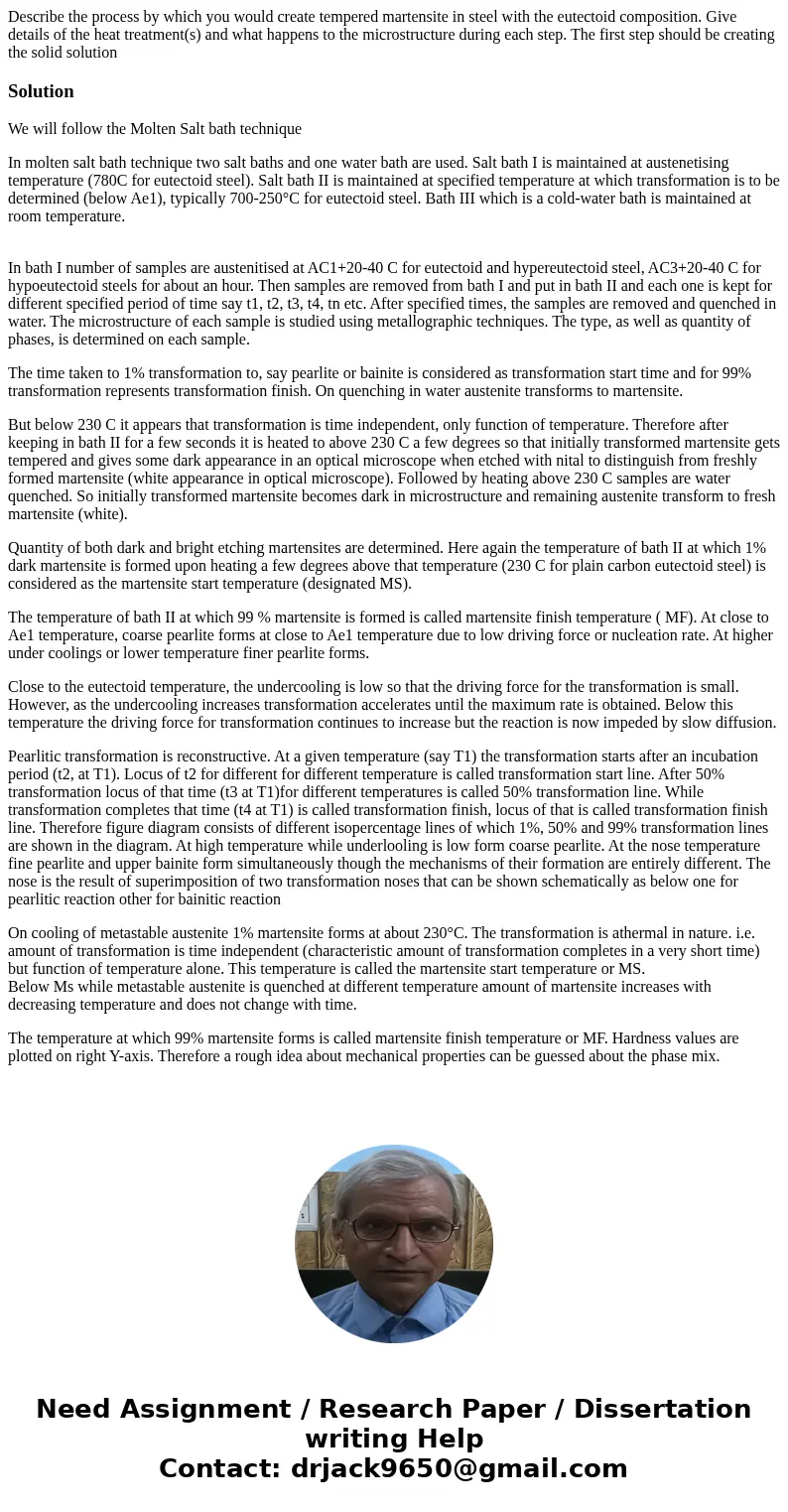Describe the process by which you would create tempered mart
Describe the process by which you would create tempered martensite in steel with the eutectoid composition. Give details of the heat treatment(s) and what happens to the microstructure during each step. The first step should be creating the solid solution
Solution
We will follow the Molten Salt bath technique
In molten salt bath technique two salt baths and one water bath are used. Salt bath I is maintained at austenetising temperature (780C for eutectoid steel). Salt bath II is maintained at specified temperature at which transformation is to be determined (below Ae1), typically 700-250°C for eutectoid steel. Bath III which is a cold-water bath is maintained at room temperature.
In bath I number of samples are austenitised at AC1+20-40 C for eutectoid and hypereutectoid steel, AC3+20-40 C for hypoeutectoid steels for about an hour. Then samples are removed from bath I and put in bath II and each one is kept for different specified period of time say t1, t2, t3, t4, tn etc. After specified times, the samples are removed and quenched in water. The microstructure of each sample is studied using metallographic techniques. The type, as well as quantity of phases, is determined on each sample.
The time taken to 1% transformation to, say pearlite or bainite is considered as transformation start time and for 99% transformation represents transformation finish. On quenching in water austenite transforms to martensite.
But below 230 C it appears that transformation is time independent, only function of temperature. Therefore after keeping in bath II for a few seconds it is heated to above 230 C a few degrees so that initially transformed martensite gets tempered and gives some dark appearance in an optical microscope when etched with nital to distinguish from freshly formed martensite (white appearance in optical microscope). Followed by heating above 230 C samples are water quenched. So initially transformed martensite becomes dark in microstructure and remaining austenite transform to fresh martensite (white).
Quantity of both dark and bright etching martensites are determined. Here again the temperature of bath II at which 1% dark martensite is formed upon heating a few degrees above that temperature (230 C for plain carbon eutectoid steel) is considered as the martensite start temperature (designated MS).
The temperature of bath II at which 99 % martensite is formed is called martensite finish temperature ( MF). At close to Ae1 temperature, coarse pearlite forms at close to Ae1 temperature due to low driving force or nucleation rate. At higher under coolings or lower temperature finer pearlite forms.
Close to the eutectoid temperature, the undercooling is low so that the driving force for the transformation is small. However, as the undercooling increases transformation accelerates until the maximum rate is obtained. Below this temperature the driving force for transformation continues to increase but the reaction is now impeded by slow diffusion.
Pearlitic transformation is reconstructive. At a given temperature (say T1) the transformation starts after an incubation period (t2, at T1). Locus of t2 for different for different temperature is called transformation start line. After 50% transformation locus of that time (t3 at T1)for different temperatures is called 50% transformation line. While transformation completes that time (t4 at T1) is called transformation finish, locus of that is called transformation finish line. Therefore figure diagram consists of different isopercentage lines of which 1%, 50% and 99% transformation lines are shown in the diagram. At high temperature while underlooling is low form coarse pearlite. At the nose temperature fine pearlite and upper bainite form simultaneously though the mechanisms of their formation are entirely different. The nose is the result of superimposition of two transformation noses that can be shown schematically as below one for pearlitic reaction other for bainitic reaction
On cooling of metastable austenite 1% martensite forms at about 230°C. The transformation is athermal in nature. i.e. amount of transformation is time independent (characteristic amount of transformation completes in a very short time) but function of temperature alone. This temperature is called the martensite start temperature or MS.
Below Ms while metastable austenite is quenched at different temperature amount of martensite increases with decreasing temperature and does not change with time.
The temperature at which 99% martensite forms is called martensite finish temperature or MF. Hardness values are plotted on right Y-axis. Therefore a rough idea about mechanical properties can be guessed about the phase mix.

 Homework Sourse
Homework Sourse